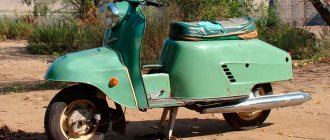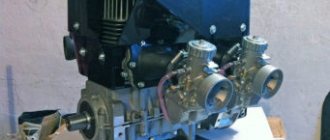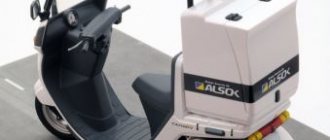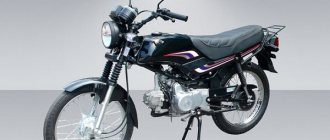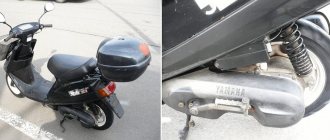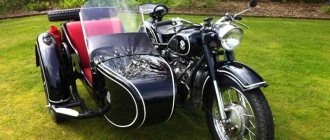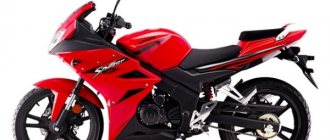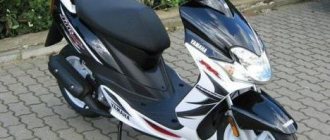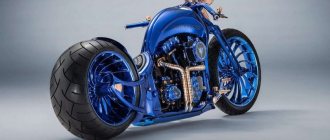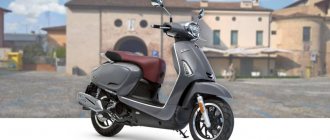Each motor of “rice” scooters has its own marking, which encodes the features of a particular unit. During scheduled scooter repairs (or unscheduled ones), many owners encounter some difficulties in finding spare parts, because they search for the main parts by the model name and not the engine marking. To do this, I recommend that you carefully examine the scooter’s engine, and after washing it of oil and dirt, find engraved numbers and Latin letters there. Most often, the location of these inscriptions is in two places:
Quite often I see how on forums and thematic groups on social networks, fans of the Chinese motorcycle industry argue that, for example, 152QMI and 157QMJ are different engines in principle. Let's figure out what all these numbers and letters mean. The first digit " 1
"(
1
39QMB) in the marking will indicate that the engine has 1 cylinder.
If you suddenly see the number “2” - go nuts, the scooter’s engine is two-cylinder. The letter “P” (1P39QMB) indicates that the cylinder is in a horizontal position. If the letter “P” is missing, then the cylinder on the scooter is not necessarily horizontal. So 139QMB and 1P39QMB, whatever one may say, are the same engines. The next two digits in the designation are “39”, “ 52
”, etc.
(1 52
QMI) denote the internal diameter of the cylinder liner, and accordingly the diameter of the piston and rings in the piston group.
The first letter
speaks about the scooter’s cooling system: “F” (139FMB, 1P39FMB) - air cooling of the motor occurs by free flow;
“Q” (139QMB, 152QMI, 157QMJ) - forced air cooling, there is a blower casing on the cylinder. If the letter is missing, the engine is most likely water-cooled (172MM - CH250). Second letter
— engine type: “M” (139QMA, 139FMA) — motorcycle engine.
The third letter
in the marking corresponds to the working volume of the cylinder-piston group of the scooter: “A” - up to 50 cubic meters (139QMA) - “honest” fifty dollars); “B” - up to 70 cubic meters (139QMB) - the most common, “almost honest” half-shock, which according to the rules should be labeled as 147QMB or even 150QMB;
"G" - up to 100 cubes; “H” - from 100 to 125 cubes (a rare variety of the GY6 family);
“I” - from 120 to 130 cubic meters (152OMI);
“J” - from 150 to 155 cubic meters (157QMJ);
“M” - up to 250 cc (172MM) - Chinese dropsy clone of Honda Spacy / Freeway with CH 250 engine.
Engines of the ARN family are also often found, with markings such as 153QMI, 157QMJ-H, 158QMI. Such engines are installed on Keeway and Stels scooters. They are often confused with the GY6 152QMI and 157QMJ family, both in the cylinder-piston group and in the cylinder head and all other parts of the engine. Although they are visually similar (152qmi-153qmi and 157qmj-158qmj), when purchasing spare parts it is worth checking these details with the seller. Concluding the “debriefing” on the dispute about 152QMI and 157QMJ, I would like to add on my own behalf that the engine data differs only in the cylinder displacement (52.4 mm and 57.4 mm). And such engines can also be called 1P52QM and 1P57QMJ.
Using this table you can identify your scooter down to the year of manufacture. This is very useful when buying a scooter, since you can determine the year of its manufacture, see if the original engine was replaced with an engine of a different model, if the frame is original, etc.
And now the explanations:
Type designation: model number assigned by the manufacturer
Scooter model: the name of the scooter that is often written on the lining :)
Manufacturer name: alphanumeric model name
Frame number: the frame number (usually written under the frame) from which the scooter was produced
Engine type: The engine type is usually written on the engine itself.
Year: the year the scooter was launched
Note: additional data on engine power, etc.
Engine Features
The official manufacturer of the 139QMB scooter engine is Hongling Corporation, which equips motorcycles not only of its own brand, but also of other brands with this engine.
The corporation sells power units to other manufacturers. The motor itself is very recognizable: the design features of the 139QMB engine and its markings on the left side of the crankcase immediately make it clear what kind of heart beats the scooter.
The motor has no flaws, does not require special treatment and calmly tolerates minor negligence and negligence. The manufacturer provides a guarantee for its products that covers the first 5 thousand kilometers. This mileage is enough for the new 139QMB 4t scooter engine to fully run in and grind in all elements and components of the systems.
The total service life of the engine is about 20 thousand kilometers, with the exception of 5 thousand running-in at an average driving speed of 90 km/h. The technical characteristics of the 139QMB engine are not bad: its power is enough for a two-seater full-size scooter.
What oil should I use?
Available types of oils for four-stroke engines: SAE 5W-20 or 10W-40. Depends on the manufacturer. If the vehicle is often operated in high temperature conditions, it is better to choose a motor oil with a high viscosity index.
What to look for when choosing oil? First of all, on the oil indices, which should be present on the canister label. The chemical composition is also no less important. In addition to the index, the exact amount of additives from the fluid manufacturer is used.
For a four-stroke scooter engine, you can use not only oil that is intended for scooters, but also for equipment: walk-behind tractors, lawn mowers, chainsaws and others.
all about your Ketai engines
#1 loki
- Moderators
- 5,490 messages
- Samara city
- Technique: v-max
All engines in China have two names: one is used within the country between different factories, the second is for the whole world. This is what the letters on the engine mean, what the manufacturer writes and what is included in the technical documentation. For example: JS1P39FMA08002488 The first two or three letters are the abbreviation of the manufacturer; if there are no letters, then the engine was made to order from a neighboring plant, and they asked the office, and the engine will be installed on a model with a different brand. There are cases when small assembly lines are “embarrassed” to advertise their name, and also forget to put these letters on the motor. the number “1” means that the engine has one cylinder, if the engine has the number “2”, it means the engine is two-cylinder. the letter “P” - the cylinder in the engine is located horizontally; if there is no letter, then the cylinder has a position other than horizontal. “39” - internal diameter of the cylinder “F” - the engine is air-cooled, if the letter “Q” is written, it means forced air cooling, if the letter is missing, it means water cooling The letter “M” is a motorcycle engine The third letter, after the digital designation of the cylinder diameter — means cylinder volume: A — up to 50 cm3; B - up to 70 cm3; G - up to 100 cm3; N - 100 to 125 cm3; I - 120 - 125 cm3; J - 150 cm3; L - up to 200 cm3; M - up to 250 cm3. But, these designations are valid only for the engine stated in the technical documentation of the manufacturer. In fact, the plant can release a modification of the engine - in a forced version or in a depowered version. This can be seen more clearly in the engine catalog of a very respected plant in China. Unfortunately for some, and fortunately for others, it is impossible to determine the REAL cylinder volume of a particular device by the name of the engine. Eight digits after the engine name: the first two are the year of manufacture, the remaining six are the engine serial number.
Analogues - engine 1P39QMB
Chinese developers have created an analogue of the Japanese 139QMB engine - a motor labeled 1P39QMB, which in appearance completely replicates the original. Despite all the similarities, you can still find differences: the valve clearances on the 1P39QMB are not adjustable. The situation is similar with the carburetor: before direct operation it requires thorough cleaning and correct adjustment. Chinese copies of 139QMB engines, of course, cope with their task, but their main purpose was to reduce the final cost of motor vehicles. Budget versions of scooters are equipped with exactly the same versions of engines that are good only for short trips at low speeds.
Before starting operation, be sure to carry out a full run-in of the 1P39QMB engine. The optimal operating mode of the engine begins only after 2 thousand kilometers, but after 10 thousand kilometers all its technical characteristics drop, and it loses dynamics and power.
1p39qmb engine technical specifications
Chinese scooter engine
Most Chinese scooter owners eventually face engine repairs. And here the problem arises in finding spare parts; many try to find spare parts for the name of the scooter, which is printed on the scooter itself as stickers. Most often, it is almost impossible to find spare parts for a Chinese scooter by model name. Because Chinese manufacturers rarely stick to one name for scooters, every year developers can visually release the same model under different names. How to find spare parts and what engines are on scooters, you will learn from this article. Often, the name of the scooter does not help in finding spare parts; in this case, the engine marking will come in handy. There are several types of Chinese engines. The Chinese do not develop new engine models, nor do they modify or upgrade engines. The Chinese are copying existing models of Japanese engines that have been discontinued. The engine that is on your Chinese scooter is identical to the Japanese engines on Honda, Suzuki, Yamaha scooters that were produced 15-20 years ago.
In this article we will talk about the most famous models and try to clearly explain the markings of Chinese engines.
Every Chinese scooter is equipped with an internal combustion engine, which is divided into two types: two-stroke and four-stroke. All engines have their own markings on the crankcase. The marking consists of a set of numbers and letters, and can tell, for example, about the manufacturer, engine size, piston diameter, number and location of the cylinder.
When searching for spare parts for a Chinese scooter, it is very important to find out the engine markings; most often they are stamped on the left side of the engine crankcase itself. Below is a list of letter designations.
Characteristics of the third letter in the engine marking A - up to 50cc (cc); B – up to 70cc (cube); G – up to 100cc (cube); N – 100 to 125cc (cube); I – 120 to 125cc (cube); J – 150cc (cube); L – up to 200cc (cube); M – up to 250cc (cube);
Additional letter designation P – horizontal engine; Q – forced air cooling (impeller); F – air cooling by oncoming (counter) flow; M – the engine is suitable for motorcycle equipment;
Let's look at an example of 139QMB engine marking below. The top designation is a characteristic of the engine, and the bottom row of numbers contains the number of the engine itself.
Decoding of the engine 139QMB, 139QMA (1Р39QMB / 1P39QMA): – Number 1 tells us about the number of cylinders (there is just one); – The number 39 indicates the diameter of the piston or cylinder; – The letter Q means that the engine is forced air cooled; – The letter M usually means that the engine is suitable for motorcycles; – The letter A or B marks an engine with a volume of 50-70cc (cc).
If you have the marking 1P39QMB / 1P39QM, then the letter P will mean a horizontal arrangement of the cylinder. For greater clarity, we will give an example of exactly what the 139QMB engine looks like.
Next, consider an engine such as 157QMJ (1P57QMJ). This engine has a volume of 150cc (cube), scooters with this engine usually look larger than usual. And their speed is an order of magnitude higher than ordinary “fifty kopecks”. The marking of such an engine is very similar to the example above, so we will not go into detailed research and will only talk about the main technical points.
When to adjust valves
Experts recommend carrying out the first adjustment of the unit and diagnosing backlashes after the first 500 km of motor vehicle mileage, and 5-7 thousand km thereafter.
Service work will also be required when troubleshooting engine problems, characteristic sounds, loss of power during acceleration, or when the bike stalls and it is impossible to start it.
To carry out repair work you will need a minimum set of keys and tools:
Probes Attention!
The clearances on the scooter valves must be strictly 0.05 for the upper and 0.1 for the lower, so the feeler gauges must be exclusively of the same thickness.
Engines 157QMJ
In addition to the very popular model - the 139QMB engines - Hongling Corporation produces other versions of power units, one of which is the 157QMJ. It is installed on expensive scooter models of famous brands. In terms of its technical parameters and indicators of functionality and reliability, this version is a complete analogue of 139QMB. In addition, the design features of the model are strongly reminiscent of other mass-produced Japanese engines.
The advantage of the 157QMJ is its increased service life - about 25 thousand kilometers. The engine boasts powerful dynamics and a high top speed. However, it also has its downside - the price is too high compared to previous versions of the engines.
Honda Super Cub
Honda Super Cub
— a scooter produced by the Japanese company Honda with a 50-125 cm 3 engine. Produced with minor changes since 1958; The emergence of the concept of “scooterette” is connected precisely with it. It is the most popular motor vehicle ever produced [1] - the total circulation of the original Honda alone, not counting Chinese copies, reached 100 million units in October 2021 [2] and production continues. The “Super Cub” engine, including various clones, is one of the most common in cheap motorcycles of the 50-150 cm 3 class from manufacturers all over the world.
Content
- 1. History
- 2 Advertising campaign of the 60s in the USA
- 3 Modifications
- 4 Super Cub engine and its clones
- 5 Notes
History [edit | edit code]
Honda Motor Co., a company that started in 1948 with the production of bicycle motors from the remains of military components, and was initially located in a wooden barn, by the mid-50s was already producing full-fledged, although not revolutionary, motorcycles and began to look closely at extensive and complex motor markets of the United States and Europe. The future expansion of the production of affordable motorcycles, according to corporate legend, was based on two ideas. Firstly, in the series of consistent preferences of the poor post-war buyer in Europe and Japan “motorcycle-motor scooter-motorcycle-minicar” there was no place for the motorcycle, and it was necessary to come up with a way to occupy it. Secondly, in the words of the company's then general manager Takeo Fujisawa, addressed to engineers, “if you design a small motorcycle, say a 50 cc, with a cover that covers the engine with all the wires and hoses, I can sell it; If a motorcycle is so easy to operate that you can drive it with one hand while holding a tray of noodles in the other, then every noodle peddler in this country, no matter how many there are, will buy himself such a car.”
The founder, director and leading engineer of the company, Soichiro Honda, heeded the words of the financier and, having previously visited the showrooms of European competitors, set about designing the future “Super Cab”. Before that, among the Honda models there was already a “Cub” - without the prefix “super” - which was an ordinary motorbike with an engine suspended on the side of the rear wheel. The name translated from English means “puppy”, “cub” - they decided to keep it for the new model of the youngest class in the range. But compared to a motorbike, it was already a “super baby”: a normal motorcycle layout, an engine with a kickstarter, a three-speed gearbox and an automatic clutch, advanced cladding, spring suspension and a soft saddle, full-fledged instruments and lights. When the finished prototype was presented to Fujisawa, he stated that he would be able to sell 30 thousand of these devices per month - one and a half times more than the entire Japanese motorcycle market at that time.
A plant was built specifically for the new model in Suzuka with the expectation of producing 30 thousand “Cubs” per month, and after expansion - up to 50, modeled on the Volkswagen Beetle production line in Germany. The plant cost the company 10 billion yen, and experts at the time considered such an investment “extremely risky” and the target American market “saturated.” However, by 1960, the enterprise successfully reached its designed capacity, becoming the largest motorcycle plant in the world. In mass production, the cost of "Kab" decreased by 18%. At the same time, the development of the dealer network was somewhat delayed, and the company was faced with a temporary overstocking.
Over the course of half a century, the Cub has gone through several restylings - the appearance of a cheap mass-produced car greatly affects its sales, even if the mechanical part is perfect. A 4-speed gearbox, electric starter, contactless ignition and other amenities were introduced. 90 and 110 cc versions appeared, as well as a 125 cc version for the 2019 model year. The production of the original Honda was repeatedly expanded by foreign branches - mainly in Southeast Asia, but also in Latin America, Africa (Nigeria) and even Europe (Belgium, 1963). The successful engine was used on several light Honda models - the popular mini-bike Monkey, light motorcycle Honda 70 and others. As of now (2019), Super Cub is still relevant. The original sells well due to traditional Japanese quality, controlled by the company regardless of the place of production. In the Asian and post-Soviet markets, the “native” Honda has been supplanted by even cheaper Asian clones, which, however, are distinguished by very unstable quality of frame metal, welding, cladding and drive chains. The cloned engine remains “indestructible” if basic operating and maintenance standards are observed. Alloy wheels, telescopic forks and front disc brakes have become common on clone scooters.
Engine D1E41QMB
The D1E41QMB motor is the only two-stroke engine model made in China. A distinctive feature of this engine from other representatives of the category of power units is the presence of a chain reverse gear in the design. The uninterrupted operation of such an engine is ensured by mixing gasoline and oil in proportions of 40 to 1. The working life of the engine is about 10 thousand kilometers, after which the need for repairs arises. The disadvantage of the engine is the forced speed limit - no more than 50 km/h.
Running in the engine
Incorrectly carried out running-in of the 139QMB engine in most cases leads to failure of the piston system. Friction occurs between the parts of the new CPG, which leads to an increase in engine temperature.
Running in the scooter motor is carried out as follows:
After carrying out such manipulations, you can run in the scooter itself. In the first 100 kilometers of the journey, you should not turn the throttle handle more than 1/3 of its full stroke. The maximum speed should not exceed 30 km/h. The speed can be increased by 15–20 km/h for the next 300 kilometers - during this time the engine should more or less reveal its potential.
After this break-in process, the oil must be changed.
Engine valves are adjusted every 500 kilometers.
CPG 4T engine.139FMB (moped) d=50 82cc
CPG 4T engine.139FMB (moped) d=50 82cc buy in the online store of spare parts for scooters, mopeds, motorcycles scooter-ani.ru.
Delivery across Russia. 1. Delivery to the address by courier service:
Delivery of orders is carried out by courier service from 9-00 to 21-00 from Monday to Friday (only in Moscow within the Moscow Ring Road).
Delivery of orders in Moscow is carried out within 1 - 2 working days, after the order is assembled, the cost is 400 rubles.
Delivery of orders within Moscow region is carried out within 2 - 3 working days, after the order is assembled, cost from 450 rubles. depending on the distance from the Moscow Ring Road, it is calculated separately by the company manager.
Delivery of orders in St. Petersburg is carried out within 2 - 3 working days, after the order is assembled, the cost is 500 rubles.
Delivery of orders throughout Russia is carried out within 3-10 working days, after the order is assembled, cost from 550 rubles.
Heavy (from 10 kg) and large-sized (plastic, etc.) parcels are sent only with 100% prepayment and the delivery cost is calculated separately.
2. PICKUP from the point of delivery of orders of the courier service SDEK, IML:
Minimum order amount -300 rub.
Delivery of orders to pick-up points (points of delivery) is carried out within 1 - 2 working days, after the order is assembled, cost from 210 rubles. depending on the selected delivery point.
As soon as the order arrives at the pickup point, you will receive an SMS on your mobile phone number (which you indicate when placing the order) informing you that the order (No.) is at the pickup point. The shelf life at the points of issue is 7 calendar days.
You can pay for your order upon receipt at the pickup point or by prepayment.
The cost of delivery to pick-up points in the regions is calculated for standard parcels weighing no more than 10 kg. and for an amount not exceeding 10,000 rubles. Heavy and large-sized (plastic, etc.) orders are sent only with 100% prepayment and delivery costs are calculated separately.
3. BY RUSSIAN POST:
Orders are sent by post within Russia upon prepayment.
Minimum order amount -300 rub.
If any of the goods you ordered are missing, incomplete, replacement, etc., the order will be sent only after your confirmation. Orders are assembled in 1-3 days, delivery time by mail ranges from 2 to 20 days, depending on the remoteness of the region. The postal number will be sent within 1-3 days after the order is sent!
4. Transport company: Business Lines, Energy, PEC:
Sending orders to TC throughout Russia is carried out on an advance payment basis.
Transfer to the shopping center takes place within 1 - 3 business days from the moment the funds arrive in the seller’s bank account. Delivery to shopping center in Moscow is free.
Payment for delivery to your city is made directly to the shopping center upon receipt of the order!
Attention: orders are sent to TK twice a week!
1. Cash
You pay the order in cash to the courier upon receipt.
Upon receipt of the Order, you must check it for compliance with the names and quantities of items, and the quality of the goods. After paying the courier, the Client signs the invoice, thereby confirming that he has no complaints about the quality and configuration of the Order.
If a shortage, mismatch or defect is detected, you have the right to refuse the entire Order or part of it, paying only for the goods that you pick up. In this case, you pay the cost of delivery of the goods you are purchasing.
2. Non-cash transfer of funds
After placing an order, a notification with details and an attached receipt or invoice (for legal entities) will be sent email address .
You pay for the order at any bank using a receipt.
As soon as the money arrives in our account, we send the order to you.
3. Paying for purchases with a bank card
Payment for the order is made via the Internet immediately after placing it.
Payment is made through the payment page of Tinkoff Bank.
4. Payment by QR code
Payment for the order is made via the Internet immediately after placing it.
Payment is made through the payment page of Tinkoff Bank.
5. Payment for purchases from electronic wallets
YuMoney is an affordable and secure way to pay for goods and services via the Internet. Payment is made through the YuMoney payment page.
Refund procedure
To receive a full or partial refund to your card, you need to contact the online store manager. The money will automatically be returned to your card within 1-3 days. The exact refund period depends on how recently the order was placed and on the bank that issued the card (the maximum refund period cannot exceed 30 days).
Installation of 72cc (47mm) CPG on 50cc 4-stroke Chinese scooters
Those who rode Chinese 4-stroke “fifty dollars” felt that the capabilities of their engines left much to be desired. Horsepower can be added by installing a tuning kit that increases the displacement to 72 cubic meters. Sold in our store: CPG 72cc 139QMB https://www.motochasti.ru/product_info.php?cPath=105&products_id=1786 Remove the side parts of the plastic lining and the seat tank - this is already enough to disassemble the cylinder-piston group. For convenience, we also disconnected the engine-transmission unit from the frame. Disconnect all hoses and throttle cable from the carburetor and remove the carburetor. Remove the muffler by first unscrewing its mounting bolts - they are located near the oil filler neck and on the exhaust pipe. Remove the cooling shroud halves by unscrewing the screws that connect them. That's it, the motor is ready for disassembly. First, unscrew the bolts and remove the cylinder head cover. Before disassembling the engine further, align the marks of the crankshaft and camshaft - otherwise inconsistencies will arise during assembly. Sometimes the crankshaft position mark cannot be found. Then set the piston to TDC as follows: turn the crankshaft with one hand, and with the other control the position of the piston with a piece of copper or aluminum wire inserted into the spark plug hole. At this point both valves should be closed. If at least one of them is open, turn the crankshaft one more turn. In this position, make your marks with a marker - they will help during assembly. And another hint: almost always in this position one or more marks on the camshaft sprocket are aligned with the camshaft bed parting plane. Before removing the timing chain tensioner, unscrew the screw at its end. This will not only weaken the spring, but also disable the plunger locking mechanism. I would like to draw your attention right away: when assembling, first install the tensioner in place and only then screw the bolt into place. Once the tensioner is removed, the timing chain will be loosened and can be removed along with the camshaft sprocket. Be sure to tie it to something with wire - otherwise the insidious piece of iron will slip into the crankcase. If the cylinder has chain guides and a tensioner shoe, remember when disassembling which one is located. For some scooters, these parts are very similar, but they cannot be swapped! Unscrew the four cylinder head nuts. Remove the camshaft from the bed, and then, rocking from side to side, remove the head from the studs. Watch the chain: now is the most treacherous moment when it can be dropped into the crankcase, and to get it out, you will have to disassemble the entire engine! Before removing the cylinder, lower the piston to BDC. Otherwise, the piston, slipping out of the cylinder, may hit the edge of the crankcase and become deformed. Or the connecting rod will hit the crankcase, make a nick on its edge, and the joint under the cylinder will not be airtight. Being at BDC, the piston will simply slip out of the cylinder and “lie” on the crankcase wall. And again, watch the chain... To ensure that the cylinder leaves its place without resistance, take a mallet and lightly tap it. After this, remember in which direction the crankshaft was rotated, and, turning it in the opposite direction, return the piston to TDC. Before removing the pin retaining rings, plug the crankcase neck with a rag. If a ring falls into it, you will have to disassemble the entire engine: it is impossible to shake out the ring, and, as you understand, it is impossible to leave it inside. It is more convenient to work when the piston is at TDC. To remove a finger, as a rule, it is enough to remove one ring. Moreover, not with a screwdriver, as is often done, but with narrow pliers. The rings on some engines have very small antennae, but sometimes there are no antennae at all - then only an awl will help. The piston pin can now be pressed out. As a rule, it comes out with a little force, but try not to put pressure on the side of the connecting rod. Sometimes those who are especially diligent manage to bend this rather strong part. It is impossible to visually notice the resulting bend. You will learn about it only when the new piston gets awry and quickly wears out, and before that, since it will move in the cylinder with difficulty, the engine will never develop the power it is supposed to have. What's in our tuning kit? It includes: a piston with rings (piston and retaining rings), a cylinder and a set of gaskets. When assembling, lubricate all parts with engine oil. Do not skimp on oil: the first minutes of engine operation after assembly are the most critical, and parts should not run dry! The compression rings of a 4-stroke engine should not be pushed into the grooves at random. Due to their shape, they, like scrapers, scrape oil from the cylinder walls into the crankcase - they help the oil scraper ring. There is a designation on the top surface of the rings, usually the letter A, but it happens that something else is stamped into the marking. Make it a rule: any inscription on the ring should be directed towards the cylinder head! Here are the marks (highlighted with a red oval): on the generator rotor, crankcase... ...and camshaft sprocket. The cylinder is ready for dismantling... ...and now the piston. The arrow indicates the tensioner shoe. Feel the difference! The new guy has taken his place. Installing the cylinder is much more convenient with an assistant. Now you need to check the valve adjustment and screw on the cylinder head cover. Now you need to check the valve adjustment and screw on the cylinder head cover. Be sure to move the joints of the rings 120° apart from each other. Moreover, if the oil scraper ring is assembled, the upper and lower of its constituent rings must be moved apart relative to the place where the gap should be by 20 mm in each direction. Exactly how the gaps are located relative to, for example, the plane of rotation of the crankshaft is not important. Install the retaining ring so as not to deform it! Otherwise, it will not fix the finger and may jump out, damaging the cylinder wall. You can check whether the rings fit well in the grooves like this: take them by the tendril with narrow pliers and try to turn them. In the direction towards its gap, the ring should move with little resistance, and in the opposite direction - not move at all. The ends of the ring must be located in the same plane. Check it by placing it on the table, straighten it if necessary - straighten it with pliers. Remove the centering bushings from the old cylinder and install them into the new one. Find the cylinder gasket in the tuning kit and place it on the crankcase studs. In any case, when assembling the motor, use only new gaskets. As a last resort, thoroughly clean the joint between the mating parts and lubricate with silicone sealant. It can be painlessly used (in accordance with the instructions on the tube) in almost all components, except for the joint under the cylinder head and in the carburetor. When you place the cylinder on the piston, compress the piston rings using a simple crimp, such as one made from a beer can. It happens that without such a device the piston cannot be inserted into the cylinder at all. And don’t forget to lubricate the cylinder bore with engine oil first! It is better to work together: while one, squeezing the rings with his fingers, pushes the piston into the cylinder, the other pulls the timing chain. Now slow down the assembly. Since the engine has been disassembled, it makes sense to flush the carburetor, clean the combustion chamber and the exhaust port of the cylinder head. There are special liquids for removing carbon deposits from internal combustion engines. But sometimes mechanics use household liquids designed for cleaning ovens and gas stoves - they are much more effective. But this efficiency may be excessive. Such products, having “eaten” carbon deposits, are capable of “biting” the aluminum of engine parts. If you decide to do a “speed” cleaning, be careful! The recipe is as follows: heat the part with a hairdryer to 60°C, spray the contaminated surface with a household spray bottle and after two or three minutes, as soon as the carbon deposits soften (check the hardness with a wooden stick), immediately clean it off and rinse the part with water. Please note that polished parts will turn matt gray after this cleaning. Make sure the piston is at TDC. Install the cylinder head and the bed with the camshaft. The position of its sprocket for this motor should be as follows: one large hole at the top, two small ones on the sides, parallel to the edge of the cylinder head. There are different recommendations for tightening the head nuts. We follow the instructions of Piaggio. To complete them, you need a lot of patience, but gas breakthrough will not happen. Tighten the nuts crosswise first with a force of 6-7 Nm, then turn each 135°, and then another 90°. Wait a little and tighten again to 6-7 N.m and “walk” through the nuts two more times, tightening them by 90° each time. For those who find all this too complicated, there is advice: tighten all the nuts at once in a crosswise sequence with a force of 20 N.m. If the gaskets are of high quality and the mating surfaces are not damaged, then this is usually sufficient. Check the marks again and install the tensioner. Again, take your time! Once the head is removed, it's worth checking the valve clearances. What should they be? It is best to take information from the scooter manual. If it is not there, do not despair: the vast majority of scooter engines have the following clearances: at the exhaust valve - 0.15 mm, at the intake valve - 0.1 mm. Both should be closed when checking. An article on valve adjustment is here: https://www.motochasti.ru/article_info.php?articles_id=84 And only now screw on the valve cover and assemble everything else in the reverse order of disassembly. Change the oil and oil filter. That's it, engine tuning is complete. The result was not long in coming: already during the running-in, the engine made it clear that it now has more torque. And after running-in, the maximum speed increased by 15 km/h. Scoot easily carries two people. In short, after replacing the cylinder-piston group, the device is unrecognizable. Source: Moto Magazine
Engine markings for Chinese scooters! Let's sort it out piece by piece.
Each motor of “rice” scooters has its own marking, which encodes the features of a particular unit. During scheduled scooter repairs (or unscheduled ones), many owners encounter some difficulties in finding spare parts, because they search for the main parts by the model name and not the engine marking. To do this, I recommend that you carefully examine the scooter’s engine, and after washing it of oil and dirt, find engraved numbers and Latin letters there. Most often, the location of these inscriptions is in two places:
- on the crankcase, underneath the cover, in the area of the front variator
- engraving in the gearbox area, also located on the engine crankcase.
Quite often I see how on forums and thematic groups on social networks, fans of the Chinese motorcycle industry argue that, for example, 152QMI and 157QMJ are different engines in principle. Let's figure out what all these numbers and letters mean. The first digit “ 1 ” ( 1 39QMB) in the marking will indicate that the engine has 1 cylinder. If you suddenly see the number “2” - go nuts, the scooter’s engine is two-cylinder. The letter “P” (1P39QMB) indicates that the cylinder is in a horizontal position. If the letter “P” is missing, then the cylinder on the scooter is not necessarily horizontal. So 139QMB and 1P39QMB, whatever one may say, are the same engines. The next two digits in the designation are “39”, “ 52 ”, etc. (1 52 QMI) denote the internal diameter of the cylinder liner, and accordingly the diameter of the piston and rings in the piston group. The first letter speaks about the scooter’s cooling system: “F” (139FMB, 1P39FMB) - air cooling of the motor occurs by free flow;
“Q” (139QMB, 152QMI, 157QMJ) - forced air cooling, there is a blower casing on the cylinder. If the letter is missing, the engine is most likely water-cooled (172MM - CH250). The second letter is the engine type: “M” (139QMA, 139FMA) - motorcycle engine. The third letter in the marking corresponds to the working volume of the cylinder-piston group of the scooter: “A” - up to 50 cubic meters (139QMA) - “honest” fifty dollars); “B” - up to 70 cubic meters (139QMB) - the most common, “almost honest” half-shock, which according to the rules should be labeled as 147QMB or even 150QMB;
"G" - up to 100 cubes; “H” - from 100 to 125 cubes (a rare variety of the GY6 family);
“I” - from 120 to 130 cubic meters (152OMI);
“J” - from 150 to 155 cubic meters (157QMJ);
“M” - up to 250 cc (172MM) - Chinese dropsy clone of Honda Spacy / Freeway with CH 250 engine.
Engines of the ARN family are also often found, with markings such as 153QMI, 157QMJ-H, 158QMI. Such engines are installed on Keeway and Stels scooters. They are often confused with the GY6 152QMI and 157QMJ family, both in the cylinder-piston group and in the cylinder head and all other parts of the engine. Although they are visually similar (152qmi-153qmi and 157qmj-158qmj), when purchasing spare parts it is worth checking these details with the seller. Concluding the “debriefing” on the dispute about 152QMI and 157QMJ, I would like to add on my own behalf that the engine data differs only in the cylinder displacement (52.4 mm and 57.4 mm). And such engines can also be called 1P52QM and 1P57QMJ.
Engine tuning
The first thing they try to change when tuning the 139QMB engine is the cubic capacity. For this purpose, the standard piston system is replaced with an 82cc one. At the same time, a new cylinder head with enlarged valves is installed. The piston system changes along with the camshaft, since a larger amount of fuel-air mixture is required for its correct operation. A new camshaft will help increase the volume of the incoming fuel mixture, but the carburetor will still need to be replaced.
Air filter
It is not recommended to completely remove the filter element or replace it with a zero-resistance filter - this can lead to contamination of the carburetor. Experts usually recommend removing the plug that is installed at the inlet of the air filter.
Many reviews that affected the assembly of the 139QMB engine after tuning talk about installing a zero-resistance air filter. Despite the fact that this solution is one of the most popular, it is not always appropriate and justified.
The reason lies in the fact that installing such a filter leads to rapid contamination of the carburetor. The main reason for using a zero resistance filter is the need for a richer fuel mixture after installing a larger piston. However, this can be avoided by installing a new camshaft and replacing the jets in the carburetor.
Separately, it is worth noting that a standard carburetor equipped with a 16 mm diffuser is installed together with a 62–72cc piston system, while the 82cc piston system is equipped with a carburetor with an 18 mm diffuser.
For replacement, it is advisable to purchase a set of jets, since several different options may be needed to adjust the carburetor.
Alpha 72cc mopeds: description, characteristics, photos and videos
One of the most popular mopeds in our country, Alpha, is a combination of practicality and efficiency; speed, dynamics combined with a good price.
Alfa mopeds (Alfa, Alpha, or as it is also called Irbis) are equipment for an active life!
Description of the Alpha moped
The Alpha 72cc moped is one of the most famous representatives among Chinese motorcycles. This moped is perfect for use both in rural areas and on city roads. A durable iron frame, complete absence of plastic parts, large diameter wheels - simply created for domestic roads, the quality of which is far from European level.
If you ride often, the rather high seating position of the ALPHA moped makes it possible to overcome low obstacles. A big advantage when choosing a moped is its low price, which makes the purchase quite affordable. This would be a good choice for a beginner.
There are options with a side trailer.
Practical to use in rural areas. A reliable assistant in the household.
Video review of the Alpha 72cc moped
The Alfa moped has its own body kit, front and rear shock absorbers, a 4-stroke engine, in general the characteristics are impressive, they will be discussed in more detail below.
The technical characteristics of Alpha mopeds are impressive and constitute serious competition in the market for companies selling mopeds. Perhaps we should start with the engine.
The engine has 4 strokes, like a passenger car, and is air cooled. The engine capacity is 72 cubic centimeters, but with such small volumes it develops quite a lot of power.
The engine is powered by an electric starter, but if it malfunctions (this happens very rarely on a moped), you can use a kick starter, that is, start the moped manually. We started it up and now we can safely drive, a four-speed manual transmission will set us in motion.
There is a chain running from the engine to the wheel, not a driveshaft. The moped is one meter long, one meter high and half a meter wide. Its own weight (without any bells and whistles) is eighty-one kilograms. Quite light weight for such a moped. The front wheel is seventeen inches, the rear is the same, but the rear has more volume than the front. The brakes are activated by pressing the levers on the steering wheel. The brakes are of a drum design.
Moped Alpha 72 cc - technical specifications
four-stroke air-cooled
Patency
The moped has front hydraulic shock absorbers. 17-size alloy wheels provide maneuverability and at the same time stability on the road. You can ride such a moped both in the countryside and around the city, both on road and off-road.
Features of setting up the carburetor of a 2-stroke scooter
Some mopeds have their own characteristics. Perhaps the simplest carburetors are made in China. And a 2t scooter has a simpler carburetor than a four-stroke. Adjusting such a model should not be a serious obstacle. However, there are some peculiarities here too. It should be noted that the needle in the 2t carburetor determines the quality of the mixture only while the throttle valve is not raised all the way. Otherwise, the fuel jet has a much stronger effect. There is also a connection with the idle system, but not on all models.
Moscow Scooter Club
Replacing 139FMB with 152FMH
Replacing 139FMB with 152FMH
amdmen » 18 Feb 2009 02:01
Hello everyone! My name is Timofey and I’m 17. I have a ZiD Pilot 4t moped. Soon after the purchase I wanted more and I installed a 72 cc piston and played with the stars. After riding like this, I wanted more.
I searched everywhere for quite a long time and looked for a motor with 100-150 cc, but they weren’t really available anywhere, there were bummers and related to the price - they asked for 18k. As a result, I found an advertisement on the hammer about the sale of a motor for 13k. After tormenting the seller with questions, I realized that this was an option, but I was confused by the automatic clutch and only 3 forward gears and one reverse! Soon I found an unknown to me forum IRONEAGLE.RU, and on it a topic about selling a motor, like on a hammer https://ironeagle.ru/forum/topic.php?forum=10&topic=156. It turned out that this is the same motor. I corresponded with my friend Berher for a week and decided to take the motor from him. And so in the morning I met and took the motor from him. It was fun to ride on a crowded train with a 25kg box, on the subway at rush hour. But the motor came to me!
I didn’t have time to install the engine over the weekend; I was leaving.
And today, on Tuesday, I took Pilot with my friend to the 5th floor, in a building without an elevator. I quickly removed the motor.
But, I read that everyone had problems with the generator and everyone installed an old generator. Having removed my 2 covers, I saw quiet horror:
The old generator was 4-pin and had many coils, and the sensor was attached separately.
But the new one had 2 coils, one 2 times larger than the other, 5 contacts and everything was mounted with the sensor on one plate.
I have never seen a wiring diagram for a new motor, and the old generator was never installed on a new motor, and neither was the cover, because... The magnet turned out to be wider!
I despaired at first, but then I realized that the new generator has a ground contact, but the second one does not. Having figured out the pinout of both generators, I re-soldered the connectors. Then I installed the generator on the engine and placed the engine near the moped. Kicked - there is a spark! I turned the electric starter and the headlight came on!
Having finally assembled the generator and thoroughly screwed it to the engine, I placed it on the moped. The dimensions of the motor fit perfectly, all the fastenings matched. Next, 20-30 minutes of screwing and connecting.
I was forced to install the original 12mm carb. Of course it's shameful
Kika with 3 engine “grabbed” but did not start. I turned the enricher to maximum and the kick with 4 engine began to purr. I quickly turned it off because... was still at the entrance.
I replaced the trim, air filter and removed the clutch handle. Then he washed himself, collected his tools, took his helmet and went to lower the moped.
On the street it started from the first kick! I stood at the entrance for about 5 minutes, warming up the engine (it didn’t bother me that it was already 22-20).
I sat down, put the car in gear, accelerating out of habit, and stalled. I decided to put it into gear by pushing slightly with my foot) Let's go)
The semi-automatic clutch is still a mystery to me. I'm driving along the road, twitching.
I figured it out a little after 2 minutes of driving. I realized that it was shaking very strongly at medium and above average speeds. I immediately thought about Glushak! Loosening the joint between the silencer and the pipe slightly reduced the vibration. I'm thinking of sawing the plug tomorrow.
While driving, I felt immeasurable traction and acceleration. Having engaged 3rd gear while driving, the front wheel lifted up about 5 meters. I screwed up, as they say.
Vobshem drove for about 20 minutes today and parked it.
The kick has become much tighter, the sound is completely different, the engine is still very hot, but I think this exhaust problem also needs to be broken in. I'll buy a normal carb soon.
To be continued soon))) 02/17/09 23-50, amdmen.
